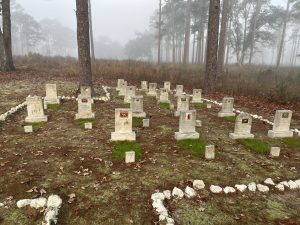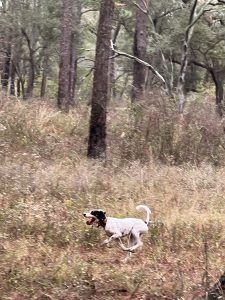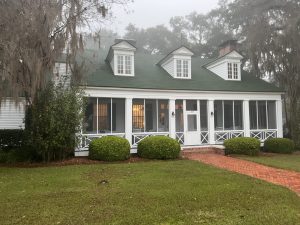
Sometimes being a water researcher has unexpected opportunities and provides for unique travel experiences — such as dining with the ambassador from Spain or visiting an ancestral kiva in the Southwest. The invitation for me and my University of Alabama and Alabama Water Institute colleague Dr. Kate Brauman to visit the Jones Research Center in Baker County, Georgia, was one such opportunity. As the director for the AWI Cultural and Water Resource Preservation Program, I was eager to pursue a partnership with the center in support of our mutual program goals of ecosystem conservation and watershed research. The Jones Center is known nationally and internationally as a first-class research facility for longleaf pine ecosystem management. Located in the Flint River watershed, the Jones Center is nestled within the historic Ichuaway Plantation created by the former Coca-Cola president and Georgia business magnate, Robert Winship Woodruff, in 1920. Our invitation to visit was received from Dr. Steven Brantley, and as part of the site tour, we were taking part in a traditional quail hunt, landscape ecology tour and laboratory visit.
On face value, a historic quail plantation might seem like a bit of a stretch for water research, however, water is central to the longleaf pine habitat and supporting ecosystems. Both fire and water are central to the management of longleaf, and the research produced at the Jones Center’s 29,000-acre living laboratory is at the forefront of illustrating the benefits of good land management for improved water quality, water availability and building resilient watersheds. The diverse ecology and habitat found at Ichauway represent the ecosystem challenges often found in the greater lower coastal plain of the Southeast. This makes the Jones Center a hub of research activity helpful to water resource conservation scientists. The center has a research program with full-time core research staff, state-of-the-art labs, graduate student researchers, dormitories for visiting scholars and generous support from the Woodruff Foundation to promote excellence in natural resource management across the Southeast.
After driving many hours, we reached the famous research center and met Dr. Brantley. Wasting no time, we loaded up and followed him to our guest accommodations. The fog was thick as it filtered through the Spanish moss hanging from the giant live oak trees that lined the driveway. A faint outline of a house could be seen from the carefully maintained dirt road, and the occasional glimpse of electric light assured us that we had not inadvertently stepped back to some earlier time in Georgia. Dr. Brauman and I had arrived at the famed Woodruff House built in 1931. As we exited our vehicle, dogs began to howl a mixed sound of excitement and longing. We both immediately paused and identified the nearby kennels as Dr. Brantley smiled, almost apologetically, and said, “For the hunt, tomorrow.”
After meeting the land manager and covering some safety basics, we settled in for the evening and prepared for the tour/hunt the following day. After a delicious breakfast, we loaded up on horse and wagon and began the slow ride across the property. As we lumbered along in the wagon, I got the opportunity to discuss the latest research interests of Dr. Brantley and (later Dr. Jeff Cannon) and share the AWI vision for our own research program. It was valuable to not only see firsthand the living laboratory that the Jones Center had worked hard to preserve, but also witness the linkages between water research outcomes and land management operations in action.
As we talked of water research and ecology, the men on horseback managed the dogs roaming the grasses in search of birds. The dogs were amazing to watch as they systematically ran full-sprint covering every available inch of ground in search of their quarry. Upon finding the scent of quail, the dogs would freeze and point with every muscle twitching with excitement. When a covey of quail was located by the dog, the master of the hunt would halt the group and signal our dismount from the horses and wagons. We would slowly ease past the dogs waiting for the tell-tale explosive sound of quail breaking for the sky. To say such small birds sound like cannons would not be an understatement for those who have heard them.
When the hunt concluded, we returned to the house for the evening meal. The food was so well prepared that I felt guilty eating it, however the conversation soon turned to the lab tour scheduled for the next morning, so we turned in early. My room smelled faintly of hickory smoke, and I slept soundly dreaming about old growth pine trees. After breakfast, we headed to the labs for a tour, and on our way, we passed an old dog cemetery. I had seen a few of these types of cemeteries before, yet not one as well maintained as this one. Mr. Woodruff certainly loved his dogs.
The labs and conference center buildings at the Jones Center are near each other allowing easy walking of the campus. The central analytic facility within the lab houses wet labs and conservation equipment while lab and field technicians have space to stage field monitoring and operations. This 18,000-square foot area boasts nine research scientist labs with specialties that compliment a holistic ecosystems science approach to natural resource management such as aquatic ecology, forest ecology, ecohydrology, etc. After the tour, we discussed potential research partnerships and agreed that many opportunities for future collaborations exist especially for hosting student field research.
As I sit here now in my university office, I can still smell the hickory smoke of the Woodruff house and feel the pine breeze on my face. Living laboratories of this size and capability in the Southeast are rare, and through the partnership of UA, AWI, CWRP and the Jones Research Center of Ichauway, hopefully UA students and researchers will get to experience the wonders of the longleaf pine savannah ecosystem like I did.




